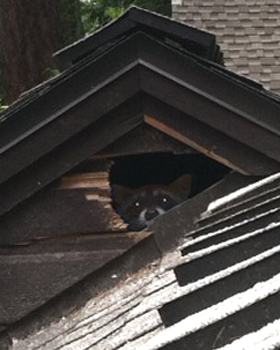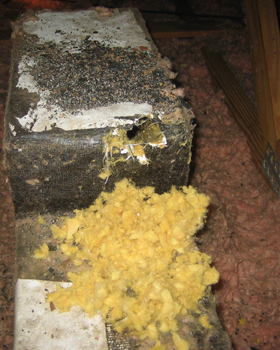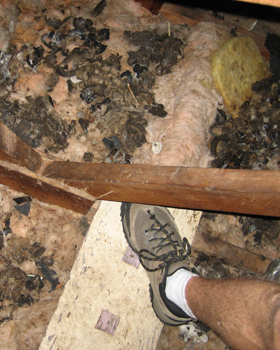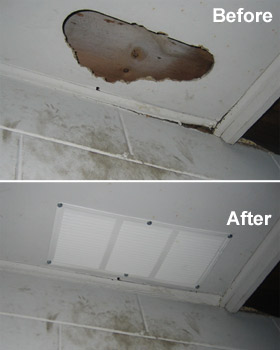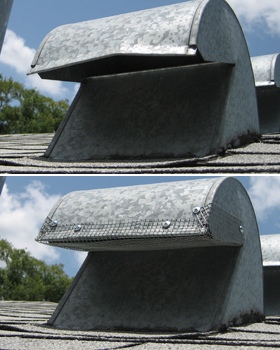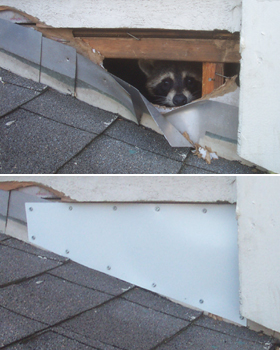DO RACCOONS ALWAYS CAUSE A LOT OF DAMAGE? - No. Surprisingly, it varies a great deal. Some raccoons will live in an attic and you'd barely know they are there. They stick to the edges, they might live in an
area with no insulation, the poop in a single latrine, etc. But some raccoons will rip open all the duct work, tear insulation off of pipes, break pipes, chew wood, chew wires, and defecate all over the entire attic in high
quantity. We do not know why raccoons behave differently - they all have different personalities. The bottom line is that having raccoons in the attic does not at all mean destructive behavior, but sometimes it does.
ENTRY POINT - Raccoons have to get inside the attic somehow. Sometimes they can take advantage of an existing opening, such as an unscreened roof vent or open soffit vent. Most of the time, no such
hole large enough for entry already exists, so they create a hole. Sometimes it's a simple matter of popping out a vinyl soffit, sometimes they completely tear open a hole in the roof, ripping through shingles and wood.
They are very strong and capable animals, and do not have a problem finding their way in if they want entry.
AIR DUCTS - Some raccoons rip open duct work. It may be for fun, it may be because they sense the air inside and are curious, or want a different temperature, or want to seek out a new route. Some raccoons
will travel in air ducts. We once removed a raccoon that had crawled through the ducts, into the air handler, where it got electrocuted and died.
PIPES - Raccoons, on rare occasion, will break the joints of pvc piping, particularly if the house has been re-plumbed with attic water lines. This can cause water leaks. If you have pipes covered in insulation
material, raccoons sometimes rip the material off. Most of the time they leave pipes alone.
INSULATION - Insulation is meant to be fluffy to work, and retain what is called its R-Value. Sometimes an active raccoon will trample down much of the insulation in an area. Sometimes they will clear an area
of insulation, or gather it, for nesting purposes. These activities may lower the R-value of insulation, but not by an important amount.
WIRES - Raccoons are not rodents. They don't need to chew to wear down their teeth, the way rodents do. So most of the time they leave wires alone. But we have seen cases in which they do chew on electrical
wires for unknown reasons, or just tear wires up as part of their normal behavior.
FECES - Raccoons in the attic will leave waste behind. Some raccoons actually try to go to the bathroom outside, or inside the attic they create a latrine of very heavy droppings. Other raccoons wander all over the
attic leaving piles of waste everywhere. There is no good explanation as to why they vary. The waste is only a problem in terms of odor, attracting bugs, and potential transmission of raccoon roundworm.
WHAT TO DO ABOUT DAMAGE? - Unfortunately it is this capacity to cause damage that makes people want to remove raccoons from the attic. If they were always clean and non-destructive perhaps more people would let them
live as tenants! What you can do, if you are on the fence about removing raccoons from the attic, is to go up there and inspect for damage. If you see that you have a relatively neat and non-destructive raccoon, maybe you will not
be in a rush to remove them, and can wait until late summer when they move out on their own. After the raccoons are out, by either waiting or humane removal (read how to get raccoons out of the attic, you want
to inspect your attic to fix any damaged ducts or wires or replace insulation. You also may want to do a cleanup job.
SEAL THE ENTRY HOLE(S) - The most important step of all when cleaning up after a raccoon habitation is to secure the attic to make sure that the same problem doesn't happen again. The entry point can usually be
identified by a thorough examination of the exterior of the property, and the usual weak points are soffits, loose vents and the points where dormer windows and walls meet the roof. It is vital that any potential entry points to
the attic are sealed, to make sure that the same problem does not happen again. Use metal flashing or steel mesh and bolt the entry areas shut, or do professional grade repairs, from wood work to shingling. Some of the better
wildlife removal companies will include this as a part of the service, while others will be able to refer you to another company to carry out this work.
HIRE A PRO - If you are unable to safely perform repair work on your home, or if you are not confident that your repairs will be sufficient, you can hire a handyman, or contractor, or a reputable wildlife control company to
perform the repairs for you. The only reason to select a wildlife control company over the others is because they will be more familiar with the types of areas raccoons like to use to enter, and they are aware of the capabilities and limits
of raccoons.
See below for some example photos of raccoon entry hole repairs. It is worth noting that if you've locked a female raccoon out of an attic, and he has a litter of young inside, she will tear the house apart to get back in! These
repairs won't hold against a truly determined raccoon.
Raccoon Waste - Should I Clean It, Or Leave it Alone? - If you think there's a risk of a person or pet coming into contact with the feces, clean it. Even if a raccoon poops in the swimming pool, the chlorine won't kill roundworm
eggs. If you don't clean feces in the attic, it's likely to attract insects, perhaps future animals, and the roundworm spores live a long time. But there's also a good chance nothing would ever happen, so long as you don't touch
or disturb the feces up there. The would get moldy, and eventually dry out, and with a lot of time, crumble into dirt. More info about raccoon poop.
How Should I Clean It? - If you do want to clean raccoon feces, wear proper protection. This includes a filter mask, like a HEPA mask, or a snug fitting N95-rated particle mask, either of which you can buy at Home Depot. You do
not want to inhale airborne eggs. Also, wear disposable rubber gloves. Optional is dosposable rubber booties or an eight-dollar Tyvek disposable suit. Once outfitted, remove the feces by hand or shovel, and bag for disposal. Remove soiled
insulation in the attic. Spray the area with an antimicrobial spray, or better yet, fog the attic space with an atomizer and a special enzyme cleaner.
For effective ways to solve a raccoon problem yourself, or to find local help, click the below buttons:

